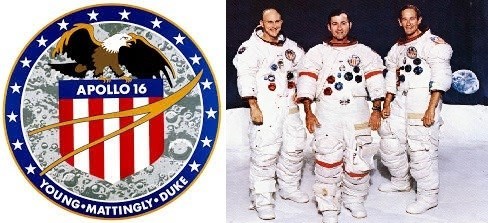Apollo 16
One of 27 caches representing all United States Spaceflight Missions of Projects Mercury, Gemini, and Apollo. This was the 10th of 11 Apollo flights and the 26th of the 27 flights. Click here to see all 27 US Spaceflight caches.
The Apollo 16 spaceflight was the tenth crewed mission in the United States Apollo space program, the fifth and second-to-last to land on the Moon, and the second to land in the lunar highlands. The second of the so-called "J missions," it was crewed by Commander John Young, Lunar Module Pilot Charles Duke and Command Module Pilot Ken Mattingly. Launched from the Kennedy Space Center in Florida at 12:54 PM EST on April 16, 1972, the mission lasted 11 days, 1 hour, and 51 minutes, and concluded at 2:45 PM EST on April 27.
Young and Duke spent 71 hours—just under three days—on the lunar surface, during which they conducted three extra-vehicular activities or moonwalks, totaling 20 hours and 14 minutes. The pair drove the Lunar Roving Vehicle (LRV), the second produced and used on the Moon, for 26.7 kilometers (16.6 mi). On the surface, Young and Duke collected 95.8 kilograms (211 lb) of lunar samples for return to Earth, while Command Module Pilot Ken Mattingly orbited in the command and service module (CSM) above to perform observations. Mattingly, staying with the command module, spent 126 hours and 64 revolutions in lunar orbit. After Young and Duke rejoined Mattingly in lunar orbit, the crew released a subsatellite from the service module (SM). During the return trip to Earth, Mattingly performed a one-hour spacewalk to retrieve several film cassettes from the exterior of the service module.
Apollo 16's landing spot in the highlands was chosen to allow the astronauts to gather geologically older lunar material than the samples obtained in three of the first four Moon landings, which were in or near lunar maria (Apollo 14 landed in the Fra Mauro Highlands). Samples from the Descartes Formation and the Cayley Formation disproved a hypothesis that the formations were volcanic in origin.
Apollo 16 Patch and Mattingly, Young, & Duke

WHY HERE?
The center point of all the US Spaceflight caches is located in the middle of the intersection where John Glenn Drive changes into Galaxy Way in Concord, CA.
Or as we geocachers would specify it: N 37° 58.700 W 122° 03.259
The distance ranges from this point to the various caches representing the spaceflights are:
- about ¼ mile - Mercury sub-orbital missions
- about 2 miles - Mercury orbital missions
- about 5 miles - Gemini missions
- about 5 miles - Apollo Earth orbital missions
- about 25 miles - Apollo moon missions
FLIGHT SUMMARY:
| Commander:_ |
_John W. Young |
| Command Module Pilot:_ |
_Thomas K. Mattingly II |
| Lunar Module Pilot:_ |
_Charles M. Duke Jr. |
| Launch Vehicle:_ |
_Saturn V |
| Height:_ |
_363.0 feet |
| Stages:_ |
_3 |
| Stage 1 Diameter:_ |
_33.0 feet |
| Stage 1 Thrust:_ |
_7,891,000 lbf |
| Stage 2 Diameter:_ |
_33.0 feet |
| Stage 2 Thrust:_ |
_1,155,800 lbf |
| Stage 3 Diameter:_ |
_21.7 feet |
| Stage 3 Thrust:_ |
_232,250 lbf |
| Launch Date & Time:_ |
_April 16, 1972, 17:54:00 UTC |
| Landing Date & Time:_ |
_April 27, 1972, 19:45:05 UTC |
| Duration:_ |
_11 days, 1 hour, 51 minutes, 5 seconds |
FTF Prize:
This is 1 of 27 caches in KCSearcher's US Spaceflight series that were given away as FTF prizes at his “Man on the Moon, July 20, 1969 - 50 years later” event. For those attendees that received this as a prize, they had an 88 hour head start on those that didn’t attend the event. The prize winners were instructed to sign the log in the “Pre-Publication FTFer(s)” space.
However, for the FTF Hounds that were not able to attend, they too had the opportunity to be FTF on this cache after publication that was targeted for 7/24/2019 @ or around 9:50 AM Pacific Time (splashdown of Apollo 11 + 50 years). All they had to do is find the cache and be first to sign in the “Post-Publication FTFer(s)” space on the log.
BONUS:
Don’t forget to record and save the Code Letter and its associated Number that is on the log sheet and inside the container lid. It will be needed to find a bonus cache on the 51st anniversary of the Moon Landing, July 20, 2020.
Please DO NOT post or include an image of the Code Letter and Number in any of your online logs for this cache
TO LEARN MORE:
Click here to see the Wikipedia description for Apollo 16.
Click here to see the Wikipedia description for Project Apollo.
Click here to see the Wikipedia description for the Space Race.